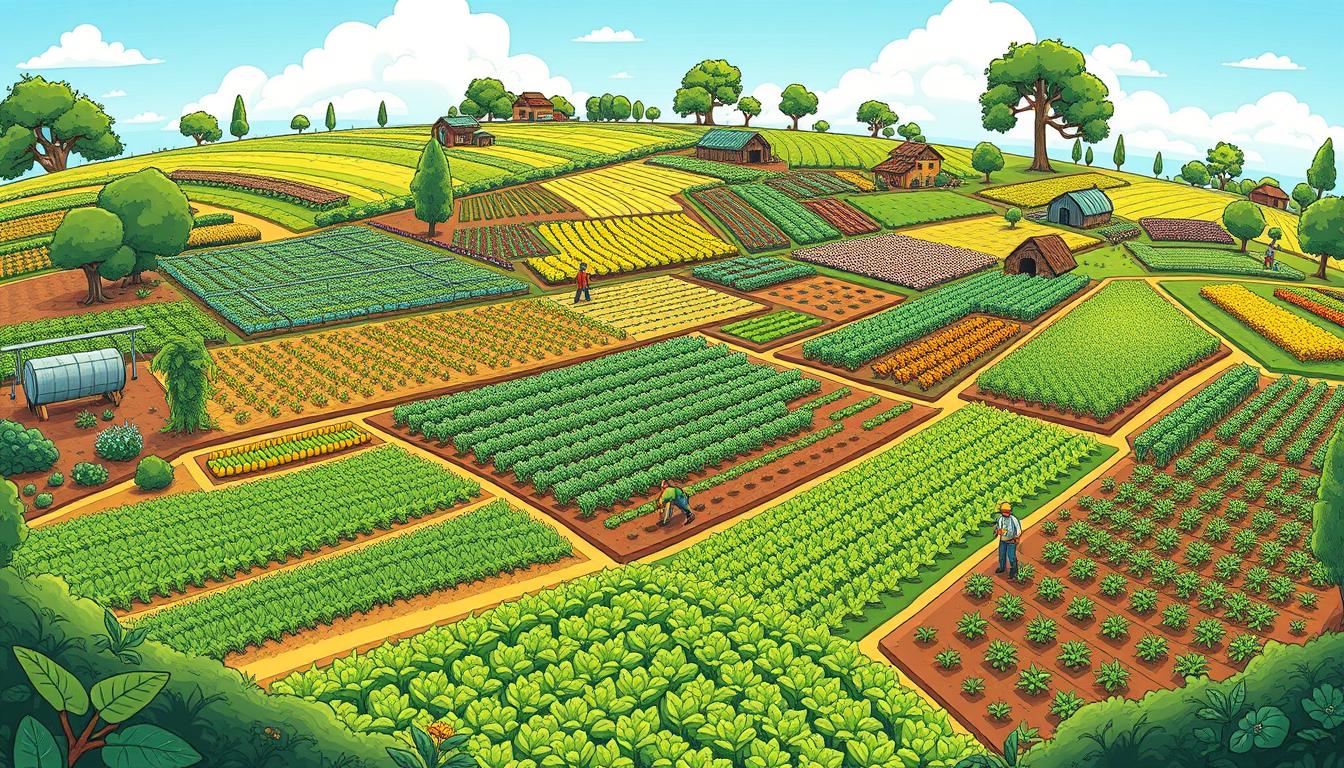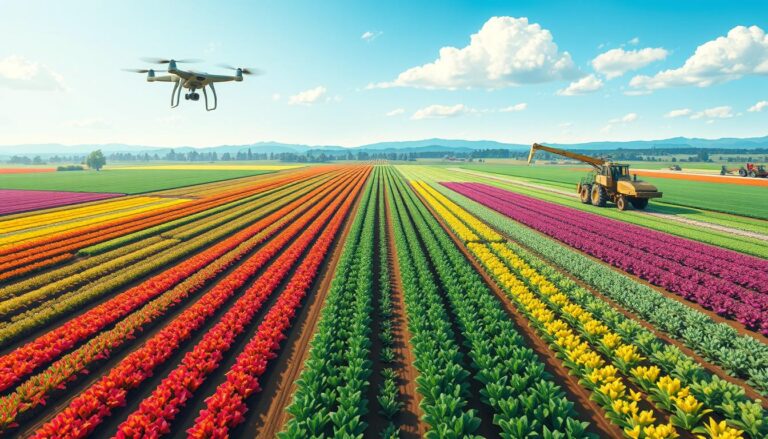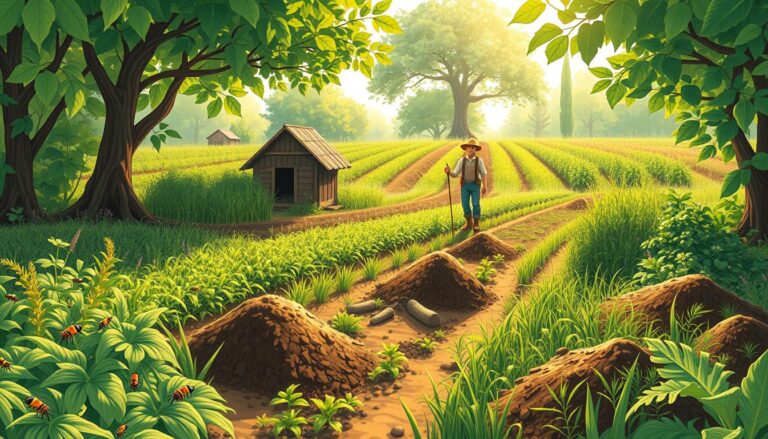Climate-Resilient Agriculture: A Sustainable Approach
In the face of climate change, sustainable farming is key for food security. Climate-resilient agriculture tackles climate challenges and extreme weather. It helps farmers boost productivity, reduce risks, and cut greenhouse gas emissions.
Groups like ActionAid help smallholder farmers, especially women, adopt sustainable practices. These methods increase crop yields and lower costs by avoiding expensive inputs. Women like Papri, Fenci, and Nayantara show how effective these techniques are.
Projects like the POWER project teach sustainable farming to women. This training helps them improve food security, earn income, and gain economic freedom. With 95% of the world’s farmers being smallholders, supporting them is essential for a sustainable future.
Key Takeaways
- Climate-resilient agriculture is a holistic approach to address climate change challenges in the agrifood system.
- Sustainable farming practices enhance productivity, reduce vulnerabilities, and contribute to mitigating greenhouse gas emissions.
- Organizations and initiatives support smallholder farmers, particularly women, in adopting climate-resilient techniques.
- Success stories demonstrate the effectiveness of sustainable agriculture practices in improving food security and livelihoods.
- Empowering smallholder farmers is crucial for ensuring a sustainable future and resilient food systems.
Understanding Climate-Resilient Agriculture
Climate-resilient agriculture helps farmers deal with climate change. It uses strategies and technologies to boost productivity and reduce emissions. This way, farmers can handle extreme weather like droughts and floods better.
What Is Climate-Resilient Agriculture?
It’s about using practices and technologies to adapt to climate change. This includes:
- Growing drought-resistant crops for dry times
- Using soil conservation methods like cover cropping to keep soil healthy
- Adopting climate-smart technologies for better water use and less waste
These methods help farmers stay productive even when the weather changes.
Importance of Adaptation in Farming
Adapting is key for farming’s future in a changing climate. Without it, farmers face big losses from extreme weather. Here are some numbers:
| Extreme Event | Losses Incurred by Farmers |
|---|---|
| Drought | $4.5 billion (2020) |
| Flood | $3.2 billion (2019) |
| Hail | $1.1 billion (2018) |
| Frost/Freeze | $2.7 billion (2021) |
Climate change also brings more pests and water issues. By adapting, farmers can grow food even when the climate is uncertain.
“Adaptation is not a choice, but a necessity for farmers in the face of climate change.” – Dr. Maria Loboda, Climate Resilience Expert
Key Practices in Climate-Resilient Agriculture
Farmers are using new strategies to fight climate change and keep food production going. These methods help deal with extreme weather, save natural resources, and keep crops growing. Let’s look at some key practices in climate-resilient agriculture.
Crop Diversification
Crop diversification means growing different crops together on the same land. This lowers the risk of losing all crops to bad weather. By growing crops that can handle drought, heat, and pests, farmers can make more money even if one crop fails. It also makes the soil healthier and fights pests.
Conservation Tillage
Conservation tillage reduces soil disturbance and keeps crop residues on the surface. It cuts down on soil erosion, keeps water in the soil, and makes the soil better. By using this method, farmers can keep the soil fertile, use less water, and protect crops from dry spells. Studies show it can also increase soil carbon and make the soil more stable.
| Practice | Benefits |
|---|---|
| Crop Diversification | Reduces risk of crop failure, enhances soil health, controls pests |
| Conservation Tillage | Minimizes soil erosion, increases water retention, improves soil structure |
Agroforestry
Agroforestry mixes trees and shrubs into farming, offering many benefits for resilience. Trees block wind, reduce erosion, and protect crops from bad weather. They also store carbon, improve soil, and give shade and shelter. Agroforestry techniques boost crop yields, diversify income, and increase biodiversity.
Supporting farmers, governments and groups are starting new projects. For example, the Indian Council of Agricultural Research (ICAR) has set up 151 climate-resilient villages. These villages show off climate-proof agricultural policies and practices. Programs like the Mahatma Gandhi National Rural Employment Guarantee Act (MGNREGA) offer jobs and promote sustainable land use and environmental care.
“Climate-resilient agriculture is not just about adapting to change; it’s about creating a more sustainable and equitable food system for all.” – Dr. Vandana Shiva, environmental activist
By using crop diversification, conservation tillage, agroforestry, and other water management strategies, farmers can fight climate change. These methods not only ensure food but also help the environment and support rural economies.
The Role of Technology in Resilience
Technology is a key tool in making farms more resilient to climate change. It helps farmers deal with changing weather, water shortages, and pests. Precision farming and drones are two big ways technology helps.
Precision Agriculture
Precision farming is a climate-smart technology that saves resources and boosts farm efficiency. It uses smart irrigation to cut down water waste and ensure crops get the right amount of water. New crops that can handle climate change are also being developed.
The Internet of Things (IoT) has changed how farms are managed. It lets farmers use data to make better decisions. Sensors on the farm track soil moisture, temperature, and nutrients, helping farmers use resources wisely.
This is especially helpful for small farmers. They grow a lot of the world’s food and are often hit hard by climate change.
Drones and Remote Sensing
Drones with cameras and sensors check on crops in real time. They help farmers spot problems early and fix them fast. Remote sensing, like satellite images, watches over big areas of land. It spots changes in plants, soil, and weather.
“The use of drones and remote sensing in agriculture has the potential to transform the way we monitor and manage crops, leading to more sustainable and resilient farming practices.” – Dr. Sarah Thompson, AgriTech Expert
Groups like CGIAR are leading the way in climate-smart tech. They work on early warning systems, risk insurance, and more. By supporting these efforts, we can make farming more sustainable and resilient.
Case Studies: Successful Implementation
Many case studies around the world show how climate-resilient agriculture works. Farmers have started using new methods to fight climate change. They’ve seen better productivity and income.
By using special crops, better animal care, and ways to hold carbon, farmers are showing it’s possible. They’re facing environmental challenges head-on.
Example of a Resilient Farm System
In Central America’s Dry Corridor, the Quesungual Slash-and-Mulch Agroforestry System is a success. It boosts yields by 50 percent and raises humidity by 20 percent. This system combines trees, crops, and animals in a way that improves soil and saves water.
The System of Rice Intensification (SRI) is another success story. It cuts down greenhouse gas emissions by up to 60 percent and increases rice yields. Farmers use water wisely, organic fertilizers, and special rice varieties to do this.
This approach helps the environment and ensures food for everyone.
Benefits Realized by Farmers
Climate-resilient farming brings many benefits. It makes soil healthier, which means more water, less erosion, and better nutrients. Healthy soil is worth trillions of dollars a year, showing its importance.
Farmers also see more food and money. For example, better soil and water management cut erosion by 11 percent and raised groundnut yields by 1.08 tons per hectare. By growing different crops and using special varieties, farmers are less affected by climate changes.
This approach also makes food more secure and nutritious. It can cut greenhouse gas emissions from farming by 40 to 70 percent. This helps farmers and fights global warming.
Challenges to Climate-Resilient Agriculture
Climate-resilient agriculture is a sustainable way to farm, but it faces challenges. It needs to overcome economic barriers and fill knowledge gaps, especially for smallholder farmers. These farmers often lack resources and information.
Economic Barriers
One big challenge is getting money for smallholder farmers. They produce most of the food in Asia and sub-Saharan Africa. But, they find it hard to get funds for new farming methods.
To solve this, we need to change how money is used for farming. We can offer subsidies, low-interest loans, or other financial help. Governments and NGOs can also help by making sure farmers get fair prices for their crops.
Knowledge Gaps
Many farmers don’t know about climate-resilient farming. They might not understand the benefits of practices like crop diversification or agroforestry. They also might not know how to use these methods well.
To fix this, we need to invest in training and extension services. This includes:
- Training programs for farmers
- Demonstration plots to show best practices
- Peer-to-peer learning networks
- Access to information and resources through digital platforms
By teaching farmers about climate-resilient practices, we can help them build stronger and more sustainable farms. This is key for facing climate change.
“Building the capacity of smallholder farmers is essential for scaling up climate-resilient agriculture and ensuring food security in a changing climate.”
| Challenge | Solution |
|---|---|
| Limited access to financial flows | Realign current financial flows to support sustainable agriculture |
| Knowledge gaps among smallholder farmers | Invest in capacity building and extension services |
Policy and Support for Farmers
Governments and NGOs are key in helping farmers face climate change. They offer financial help, create plans for sustainable farming, and build skills. These efforts help farmers use practices that reduce climate change’s effects and make farming more resilient.
Government Initiatives
Worldwide, governments are backing climate-smart farming with big investments. For example, the USDA in the U.S. is putting up to $2.8 billion into 70 projects. These projects aim to help over 50,000 farms and cover 20-25 million acres, reducing carbon dioxide by more than 50 million metric tons.
- $50 million in 118 partnerships to expand conservation assistance for climate-smart agriculture and forestry
- $10 million in the Environmental Quality Incentives Program to support climate-smart conservation practices in 10 target states
- $5 per acre premium support for producers who insured their spring crop and planted a qualifying cover crop during the 2021 crop year
- $330 million in 85 public-private partnerships through the Regional Conservation Partnership Program
NGO Contributions
NGOs are vital for research, building skills, and sharing knowledge in sustainable farming. For instance, five international NGOs helped start the Africa Climate-Smart Agriculture Alliance. The World Business Council of Sustainable Development also focuses on climate-smart farming.
In many countries, local groups have a big role in planning for climate-smart farming. They use their own funds and national budgets to help their communities.
“Leveraging investments in green and climate resilient agricultural practices is crucial to lift millions of people out of hunger and poverty.” – Food and Agriculture Organization of the United Nations (FAO)
| Initiative | Impact |
|---|---|
| Kenyan Agricultural Carbon Project (2010-2017) | Involved over 60,000 smallholder farmers, roughly half being women |
| System of Rice Intensification (Madagascar) | Helps farmers adapt to increased rainfall variability, improving drought resistance |
Together, governments, NGOs, and local groups can help farmers adopt climate-resilient farming. This ensures a sustainable future for farming and food security.
Future of Climate-Resilient Agriculture
The world faces big challenges from climate change. The future of farming depends on using practices that help meet the Paris Agreement and the Sustainable Development Goals. The agri-food sector is changing, with a focus on caring for the environment and reducing carbon emissions.
Emerging Trends
More farmers are using climate change indicators and tracking greenhouse gases in their work. This helps them, policymakers, and researchers understand how farming affects the environment. It also helps them find ways to fight and adapt to climate change.
Climate-smart technologies like precision agriculture and early warning systems are becoming more common. These tools help farmers make better decisions and work well even when the weather changes.
Community Engagement and Education
Getting people involved and teaching them about sustainable farming is key. It’s important to show how sustainable farming can help feed people and fight climate change. By working with farmers and communities, we can make a difference.
Supporting climate-resilient farming is good for the planet, our economy, and society. Together, we can make farming more sustainable and secure food for the future. This way, we can also lessen the effects of climate change on our planet.
Source Links
- Climate resilient sustainable agriculture
- An Integrated Approach to Sustainable, Climate-Resilient Agriculture
- Climate resilient agriculture
- No title found
- Climate-Smart Agriculture
- Climate resilient agriculture systems: The way ahead
- ClimateResilient Agriculture
- Increasing agricultural resilience through technology
- Climate Resilience in Agriculture: Transforming Farming for Sustainability
- How Technology Play a Major Role in Reshaping Farming Practices
- Harnessing Climate-Resilient Agriculture as a Force Multiplier for Climate and Development Goals – FP Analytics
- Transformative adaptation: from climate-smart to climate-resilient agriculture – CABI Agriculture and Bioscience
- Improving Climate Resilience through Agriculture
- Climate Resilient and Transformative Adaptation for Agriculture
- Climate Solutions
- Climate Change | Policy Support and Governance Gateway | Food and Agriculture Organization of the United Nations | Policy Support and Governance
- 5 Policy processes and instruments to support climate-smart agriculture | Sitio web del Libro de consulta sobre la agricultura climáticamente inteligente | Organización de las Naciones Unidas para la Alimentación y la Agricultura
- The path toward a climate-resilient future for Kansas agriculture
- Climate Change: Options to Enhance the Resilience of Agricultural Producers and Reduce Federal Fiscal Exposure
- Climate Resilient Agriculture: A Cornerstone for a Sustainable Future







